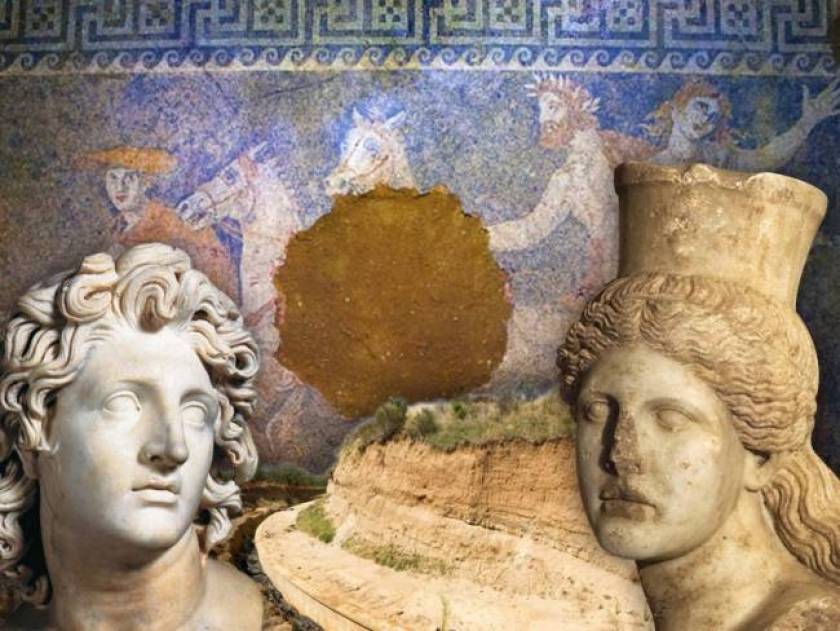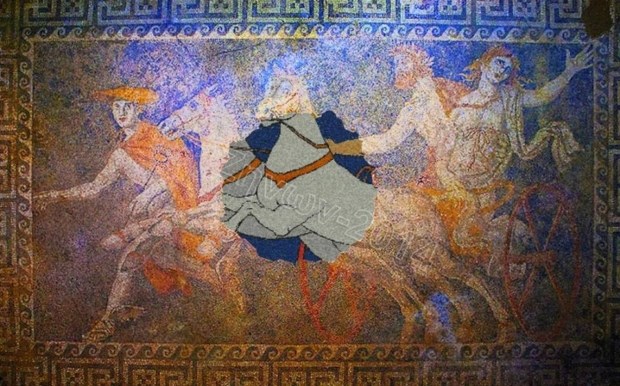Amphipolis: Why the head of the Sphinx indicates Alexander the Great

The marble head of the Eastern Sphinx, which was found 14 meters from the entrance of the burial monument of Amphipolis, sparked again the rumor that the Macedonian commander is buried there.
The Sphinxes of Amphipolis are extremely impressive even headless and archaeologists were fortunate enough to discover on Tuesday (10/21/2014), the head of the Eastern Sphinx-guard of the tomb and to complete the puzzle.
When noticed the head of the Sphinx of Amphipolis, associatively come to mind the Sphinxes in Serapeion in Memphis, south of Cairo, since they have many similarities.
The Serapeion in Memphis has something special, since according to the estimates of many scientists there is a cenotaph there in honor of Alexander the Great.

The point of the similarities between the Sphinxes in Amphipolis and those of Serapeion was brought (before even found the head of one of the two) Andrew Chang, known Egyptologist, by early September.
Indeed, Wednesday (10/22/2014) reiterated his point, speaking in Alpha, expressing his appreciation that in the Serapeion in Memphis was the first tomb of Alexander the Great and that is probably linked with the tomb in Amphipolis.
Loier and Picard, in 1955, in their book on Greek sculpture, argue that the Sphinxes of Memphis dating to the time of Ptolemy I, while Dorothy Thompson in 1998, in her book «Memphis: Under the Ptolemies», said that the sculptures form a semicircle and guarding the entrance to the tomb of Alexander the Great.
In Serapeion Egypt, it is said that was originally buried the corpse of Alexander the Great by Ptolemy.
Was the decapitation of the Sphinxes a part of funeral ritual?

Already the first findings of the third chamber, ie the head of the Sphinx and the stones found with coating and may also constituted the floor of the chamber, came to bring new questions,.
According to the announcement of the Ministry of Culture on the discoveries about the floor: "It is clear from this section, that here was located a limestone flooring, bearing white coating. On either side of the threshold we found the lime stones of the floor. On the east side of the intersection, the floor appears to have collapsed, while to the west the floor is damaged and its stones have fallen in the interior of the intersection", it seems that nothing is clear and unambiguous.
Now it seems that the floor is disordered, and within all this was found the head of the Sphinx.
The head of the Sphinx has a height of 0.60 meters and weight 80 kilograms.
According to the xronometro.com, the head was on the Sphinx above the gate and someone had moved it inside the tomb, behind the marble door which essentially indicates the beginning of the main funerary monument. What has preceded, between the gateway with the Sphinxes and the marble door of the third chamber is just a walkway. After the marble door must be the great findings, which will be difficult to be uncover.
If the beheading of Sphinxes was not part of a funerary ritual, then what else can it be? The case of tomb looting is not convincing, as the practice of the invaders was to gather the precious metals of the tomb and go, they had no reason to carry marble sculptures to the interior of the tomb ...
The symbol of Alexander the Great at the head of the Sphinx

The hallmark of the royal dynasty Temenid (royal rosettes) seems to lie in the hat of the head of the Sphinx found in the tomb of Amphipolis.
The rosette is found both in the tomb of Philip in Aigai and in representations of Alexander the Great in the late period.
The rosettes below the architrave in the second chamber show Alexander the Great.
After passing under the rosettes between the architrave and the Caryatids one enters the second chamber dominated by the impressive mosaic floor with the Rape of Persephone.
The Rape of Persephone as it was before damaged

A spectacular color representation of the mosaic which depicting the abduction of Persephone in the funerary monument of Amphipolis, was created by the painter Gerasimos Gerolymatos.
Recall that recently Gerolymatos drafted the sketches of caryatids and the gate at the entrance of the monument, by following the dimensions of the findings. He describes how he designs the space, followed by the thought of the architect.
As he says in a post on Facebook:
"Just before I finish, the representation of a mosaic of 4.5 m. at scaled dimension of 10 cm, I will make a pause to write the following.
It is a real masterpiece of ancient art! The art of mosaic, belong undoubtedly to the visual arts and in fact should be considered piece of painting, portable or monumental. The differentiation from the painting is determined by the different materials used. What the painter can easily depict with detail (expression, movement, plasticity) through colors, for the mosaic craftsman is more difficult, as the hard fossil-stone used, limits him. This is why mosaics, very often, maintain a solid grandeur, as they outline with independent color elements and interaction with the eye (I always thought that "pointillism" derives its origin from the logic of the recombine of pebbles, just Seurat and Signac made them touches) the "generality" of a composition".













